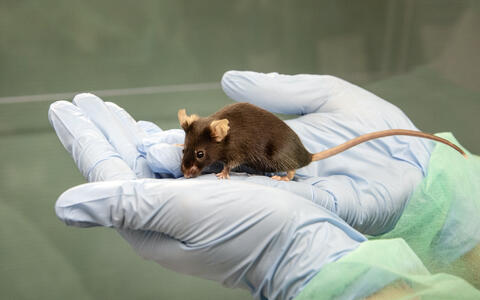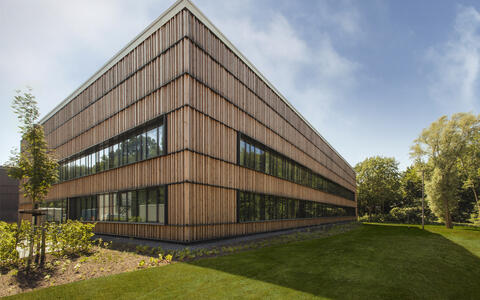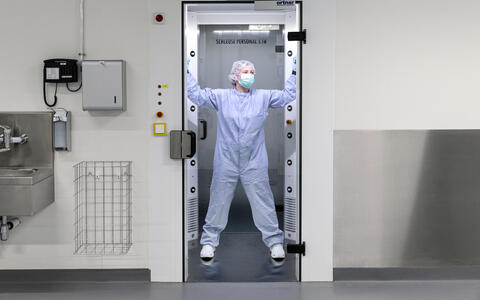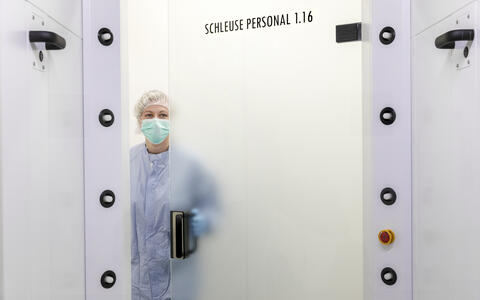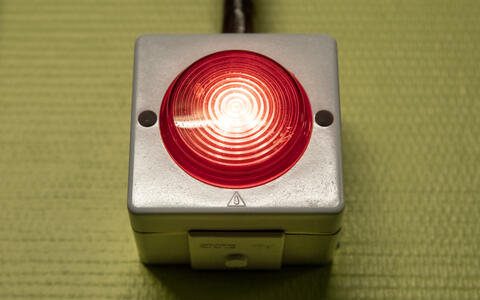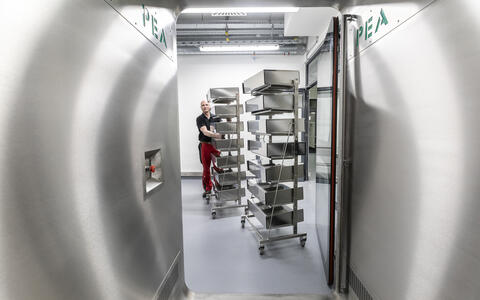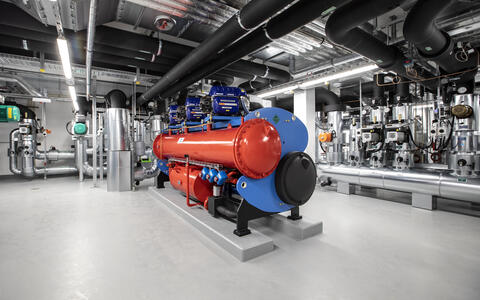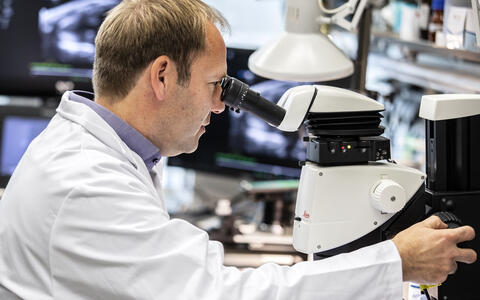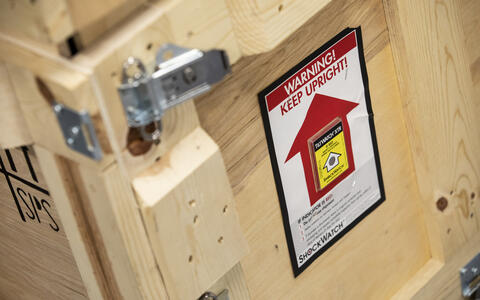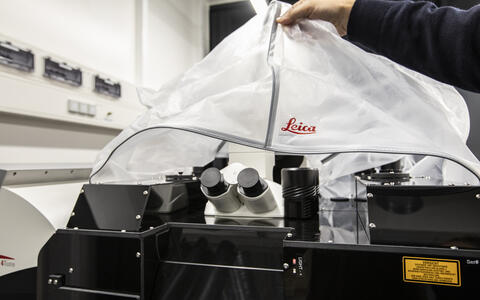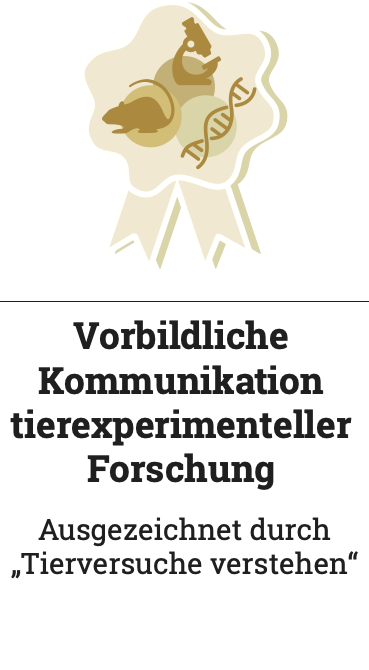Preclinical Research Center
Making experiments more animal friendly
At first glance, the red-tinted glass panes of the roughly human-height stainless steel cabinets do not reveal what is hidden behind them. Then, slowly, the mouse cages come into view. One animal stands on its hind legs to reach food, another runs around in its wheel, and a third scurries into a red tube at the back of the cage. As they do so, they are automatically being monitored down to the smallest detail: The tube measures the animal’s weight, every wheel rotation is recorded, and the food dispenser documents how much the mouse eats and when. Meanwhile, infrared photoelectric sensors allow all movements to be retraced at a later stage.
For the mice, almost nothing changes in the PhenoMaster environmental chambers – as the Max Delbrück Center’s new system is called – compared to the familiar environment of their home cage: the air is about 22 degrees Celsius; the humidity is about 55 percent; and the light goes on and off automatically, thus imitating a day-night rhythm. But all the while, sensors are constantly collecting data on the animals. By analyzing the air inside the cages, researchers can, for example, draw conclusions about the calorie expenditure of the mice and thus about their metabolism. Is the mouse still exhaling tiny amounts of acetone? This would indicate whether a new therapeutic agent was effective against diabetes.
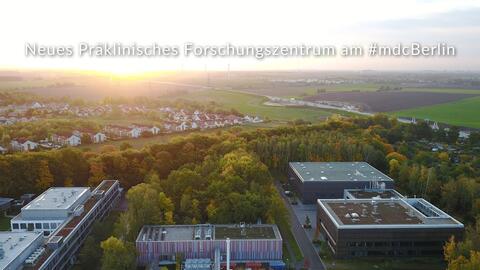
“Here at the Max Delbrück Center, we want to find new therapies for sick people that doctors have so far been unable to treat effectively,” says Professor Thomas Sommer, interim Scientific Director. Artificial intelligence, state-of-the-art sequencing methods and organoids, samples from patients, and cell culture systems can all help achieve this goal. “But none of these methods can simulate an entire organism,” explains Sommer. “We will not be able to do away with animal testing entirely for the foreseeable future. This makes it all the more important that we are constantly working to make experiments even more animal friendly and predictive.”
Optimal conditions
With its Preclinical Research Center (PRC), which began operations in 2020, the Max Delbrück Center now has a laboratory facility that provides the best possible conditions for animal research. Scientists here always work in accordance with the principles of the 3Rs – reduce, refine, and replace. All our research teams are committed to following these ethical standards, and they are working continuously to develop the 3Rs further. In short, this means an animal experiment is only allowed to take place if there are no alternative methods to achieve the desired scientific objectives. And even then, scientists may only use a minimum number of animals, and they must design the experiments so that the animals suffer as little as possible.
“For me, an optimal animal experiment is one where the animal doesn’t even notice the examination,” says Dr. Arnd Heuser, who heads the new facility and the Animal Phenotyping Platform. “A high level of animal welfare and stress-free study conditions are decisive factors in producing high-quality research findings.” The new facility will not lead to an increase in the number of laboratory animals kept at the Max Delbrück Center.
A cube of wood and glass
The cube made of wood and glass that now stands on the southeastern edge of the campus took around four years to build and cost some €24 million net. The shielded core of the building consists of several rooms off a central corridor, where all the mice and rats that our scientists need for their experiments are housed. The labs are grouped around these rooms.
A team of animal keepers looks after the animals 365 days a year and makes sure the area remains clean and sterile. Everything that comes in is thoroughly disinfected – including the cages and even pens and paper. “The animal keepers wear protective autoclaved clothing and, before entering, pass through an air shower cubicle that removes all germs, dust and pollen,” explains Dr. Claudia Gösele, who heads the experimental animal husbandry and is responsible for animal welfare at the PRC.
Elsewhere, a steam room breathes, roars and hisses like the belly of a big ship. “The steam is used to sterilize the animal feed and litter, and keeps the humidity levels optimal for the animals,” says Achim Maier, who has managed the new building project for the Max Delbrück Center since the start of the planning phase in 2010. A red-blue cooling unit stands in the adjoining room. This machine maintains the building’s temperature, which should be a constant 22 degrees Celsius – in summer and in winter. The large-scale ventilation systems in the technical center draw in outside air and pass it through three stages of filtration. To maintain the necessary clean-room conditions for keeping laboratory animals, no more than ten particles of dust may be present per cubic meter of air.
Cooling unit
Little by little, equipment and animals arrived
Gösele lifts a transparent cage from a shelf and together with an animal keeper inspects the condition of the four mice inside, which are scurrying around in their bedding. A drinking bottle hangs down from above, the feeder is full, a red box in a corner of the cage provides space to hide. “Experienced animal keepers can tell immediately if the mice are doing well,” she says. “These four here have built themselves a nice closed nest out of hemp, which is a sign of well-being.”
Now the researchers have to come to the mice, and not the other way around.
In her role as an animal welfare officer, Gösele, just like her five colleagues at the Max Delbrück Center, writes an opinion for every planned animal experiment before it is submitted to the Berlin State Office for Health and Social Affairs (LaGeSo) and intensively reviewed by an independent animal welfare committee. An experiment may not begin until approval is granted. She also monitors the experiments to ensure they are performed correctly, making regular unannounced inspection visits to the labs. “Animal welfare and animal protection are a top priority at the MDC,” she says.
While Claudia Gösele and her team organized the transport of the mice and rats to the PRC, Arnd Heuser and his group outfitted the labs with state-of-the-art technology. Equipment that was previously spread across several buildings on the campus is now centrally available to all scientists. “Now the researchers have to come to the mice, and not the other way around,” says Gösele. “This significantly reduces the stress on the animals, because they no longer have to be transported between facilities and can remain at all times in the same quiet and clean environment.”
The PRC is also being outfitted with equipment and technology that was not previously available at the Max Delbrück Center, such as a two-photon microscope and special equipment for neuroscience behavioral experiments. Many of the testing methods are commonly used on hospital patients. Among these are ultrasound and clinical chemistry, the latter of which involves the analysis of urine samples, serum or blood plasma. A magnetic resonance imaging (MRI) scanner, which was purchased specifically for the new facility, makes it possible to examine animals without any radiation exposure. Its temporal resolution is so high that the scanner can even produce detailed images of the beating heart. Mice are scanned under anesthesia, and a few minutes after the procedure is over they will scurry around again on the warmed platform.
Like a network of roots
Arnd Heuser sits at his new desk. Through large panes of glass one sees a red and yellow autumn forest, and on his computer screen is a three-dimensional black-and-white model of a rat heart, which contains vessels that resemble a multi-branched network of roots. “That is an image from our new micro-computed-tomography (micro-CT) scanner, whose resolution is so high that we can measure tiny vessels and their branches around the heart,” says Heuser.

The research group for whom Arnd Heuser’s team produced the images is searching for the causes of preeclampsia, a dangerous hypertension disease that occurs during pregnancy. One in ten pregnant women suffer from this disease, and standard medication for high blood pressure does not help them. The disease can cause very premature births and mothers face up to a four times greater risk of developing a cardiovascular disease after pregnancy. The researchers are using genetically modified rats to study how complications during pregnancy alter the heart vessels.
A contrast agent is injected into the organ, which is scanned from all sides for eight hours in a micro-CT scanner using X-rays. A scientist then creates a 3D reconstruction by assembling together the high-resolution images from the scans – thus providing a view of the heart’s interior. This is all very time-consuming, but the long-term goal is to develop a suitable therapy for the affected women and to save lives.
A milestone in our 3R strategy
On Arnd Heuser’s computer screen one sees another black-and-white video that, to a layperson, now appears to be much more blurred: It is a rat heart beating evenly. The extremely slowed-down footage is from a high-frequency ultrasound device, with which Heuser can measure how well the animal’s heart muscle is functioning. The procedure is non-invasive, which means it is conducted completely externally. The chest of the anesthetized rat is coated with gel and scanned with an ultrasound probe, the same procedure that doctors commonly perform on patients.
The main aim is to reduce patient suffering in the future.
Heuser is certain that experiments like these are necessary to understand the underlying mechanisms of diseases. “The main aim is to reduce patient suffering in the future,” he says, adding: “Like other research institutions, the Max Delbrück Center is working intensively to develop and use more alternative methods. Yet many such methods currently have limitations. In the meanwhile, the PRC is a major milestone in the 3R strategy of the Max Delbrück Center.”
Text: Mirco Lomoth / Editorial assistance: Jana Schlütter
Research, animal experiments and the 3Rs
Why animal research?
Why we cannot yet avoid animal testing
Our laboratory animals
PRC Preclinical Research Center
The 3R principles
Research without animal experiments
Mini-organ, mathematical model or mouse?
Facts and figures
Approval and monitoring
Transparent communication

